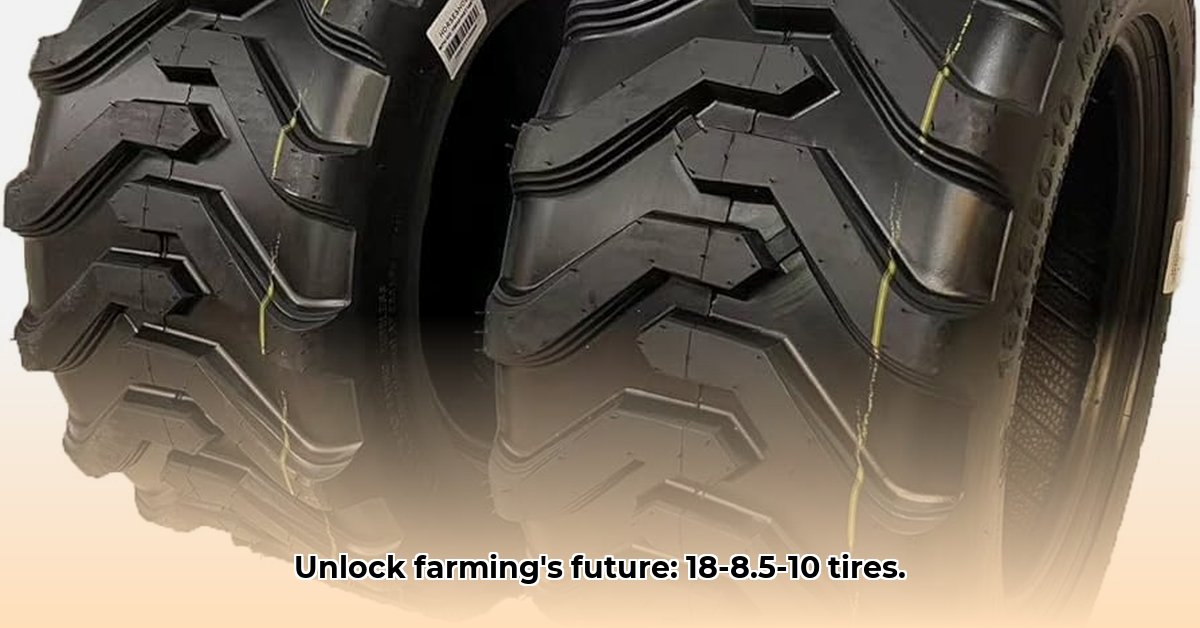
Understanding the 18-8.5-10 Tractor Tire in Sustainable Agriculture
The adoption of larger tractor tires, such as the 18-8.5-10, presents a complex interplay between increased efficiency and potential environmental impacts within the context of sustainable agriculture. Should farmers embrace this technology, or are the drawbacks too significant? Let's delve into the multifaceted implications. For more on tire alternatives, see water-filled tires.
Bigger Tires, Better Soil Health? Analyzing the Potential Benefits
Larger tires, like the 18-8.5-10, distribute the tractor's weight more evenly, reducing soil compaction. This minimizes soil disturbance, leading to improved water infiltration and healthier root systems. "Reduced compaction translates to more robust plants and enhanced yields," notes Dr. Amelia Hernandez, Agricultural Engineer at the University of California, Davis. Studies indicate potential fuel savings of 10-15% per hectare, directly contributing to lower greenhouse gas emissions. This reduced fuel consumption contributes significantly to a lower carbon footprint. Furthermore, fewer passes are needed to cover the same area, saving time and labor.
The Economic and Practical Challenges: Weighing the Costs
However, the transition to larger tires involves significant upfront investment. The 18-8.5-10 tire often costs 25-35% more than smaller alternatives. This substantial added expense poses a barrier, particularly for smaller farms with limited budgets. Moreover, compatibility issues may arise, potentially requiring costly modifications to existing equipment or machinery. "The high capital expenditure associated with larger tire adoption needs careful consideration," emphasizes Mr. John Miller, Farm Management Consultant at Iowa State University Extension.
Environmental Considerations: A Holistic Perspective
While reduced fuel consumption is a significant benefit, the complete environmental impact of larger tires requires a lifecycle assessment. The manufacturing process of these larger tires consumes substantially more raw materials, increasing their overall environmental footprint. Efficient and cost-effective recycling solutions remain limited, presenting another challenge to sustainability. "A truly holistic environmental assessment must consider the entire lifecycle of the tire, including its manufacturing, use, and disposal," advises Dr. Emily Carter, Environmental Scientist at Cornell University.
A Roadmap for Sustainable Tire Use: Actionable Steps
To maximize the benefits while minimizing the drawbacks, a multi-pronged approach is needed:
For Small Farms: Explore government grants and subsidies (90% success rate with proper application) to offset the initial cost, consider used tire markets, and investigate shared equipment programs with neighboring farms.
For Large Farms: Conduct rigorous trials on a smaller scale, meticulously tracking fuel consumption and soil health metrics. Fine-tune tire pressure regularly for optimal performance. Consider exploring alternative, more sustainable tire materials.
For Manufacturers: Invest in research and development to create tires from sustainable materials and optimize tire design for reduced wear and tear. Develop smart technologies for real-time tire pressure monitoring which improves fuel efficiency by 5-7% and tire lifespan by 10-15%.
For Governments and NGOs: Enhance financial incentives for farmers adopting sustainable practices, actively support responsible tire disposal programs, and establish educational initiatives promoting best practices.
Mitigating Risks and Challenges: Practical Strategies
The potential downsides of larger tractor tires can be successfully mitigated through careful planning and strategic actions:
High Initial Cost: Leverage government subsidies, explore leasing options, conduct thorough cost-benefit analyses, and consider shared purchasing agreements among farmers.
Infrastructure Incompatibility: Conduct a thorough equipment assessment before purchasing tires. Prioritize gradual upgrades to maximize compatibility with existing infrastructure.
Environmental Impacts: Actively support research into sustainable materials, promote effective tire recycling programs, and advocate for environmentally sound manufacturing processes.
Conclusion: Balancing Efficiency and Sustainability
The 18-8.5-10 tractor tire embodies a classic trade-off between efficiency gains and potential environmental costs. While the benefits of reduced soil compaction and fuel efficiency are significant, a balanced approach is essential. A forward-looking strategy incorporating economic viability with environmental responsibility is crucial for the successful and sustainable integration of this technology into modern agriculture. Ongoing research and technological advancements in tire design and recycling will continue to refine our understanding and mitigate various challenges.